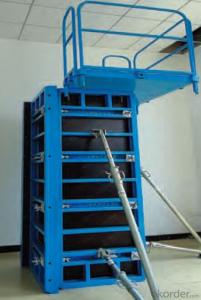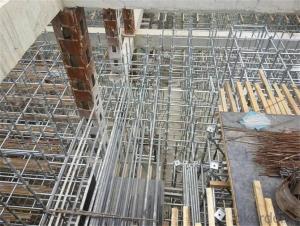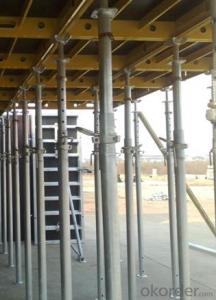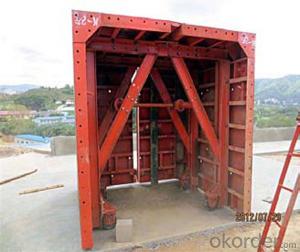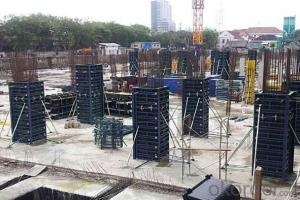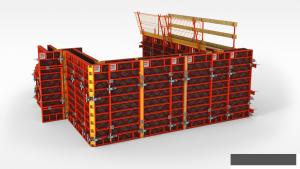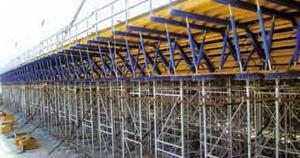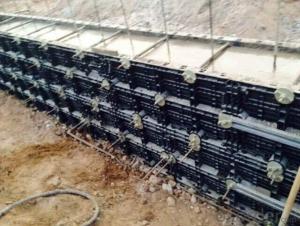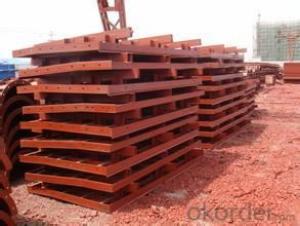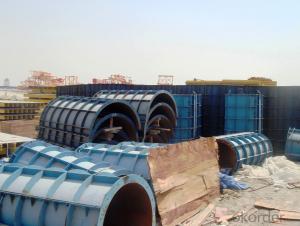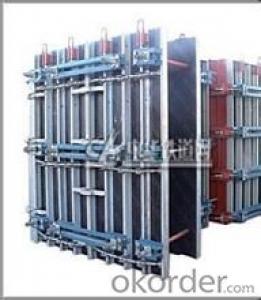Adjustable H20 Timber Beam Formwork
- Loading Port:
- China Main Port
- Payment Terms:
- TT OR LC
- Min Order Qty:
- -
- Supply Capability:
- -
OKorder Service Pledge
OKorder Financial Service
You Might Also Like
Detailed Product Description
Light weight Formwork
high bearing capacity Formwork
Rectangle Concrete Column Formwork
Square Concrete Column Formwork
H20 Timber Beam Formwork for Rectangle, Square Concrete Column Formwork
Description:
1. Structure sketch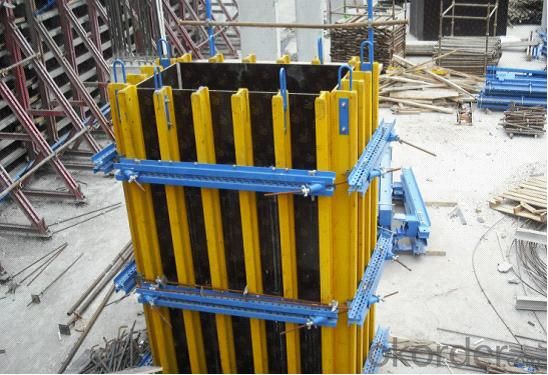
TBC system-A is a kind of formwork for pouring square or rectangle column, it is composed of four pieces of Tim-formwork, yoke, tie rod, wing nut, etc.
It will be designed according to column’s size; the formwork’s dimension is not adjustable.
Competitive Advantage:
1. Prefabricated connection, convenient and efficient.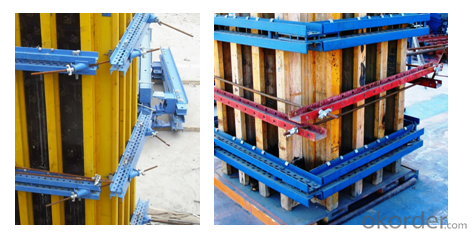
2. Light weight but high bearing capacity.
For conventional design, its load bearing capacity is 80KN/m2 with weight of 55-65kg/m2.
If required, the formwork can be specially designed for higher concrete pressures.
3. Timber is easy resized, so the Tim-formwork is relatively easier to change self’s size and shape. This approved formwork’s economical efficiency.
Applications:
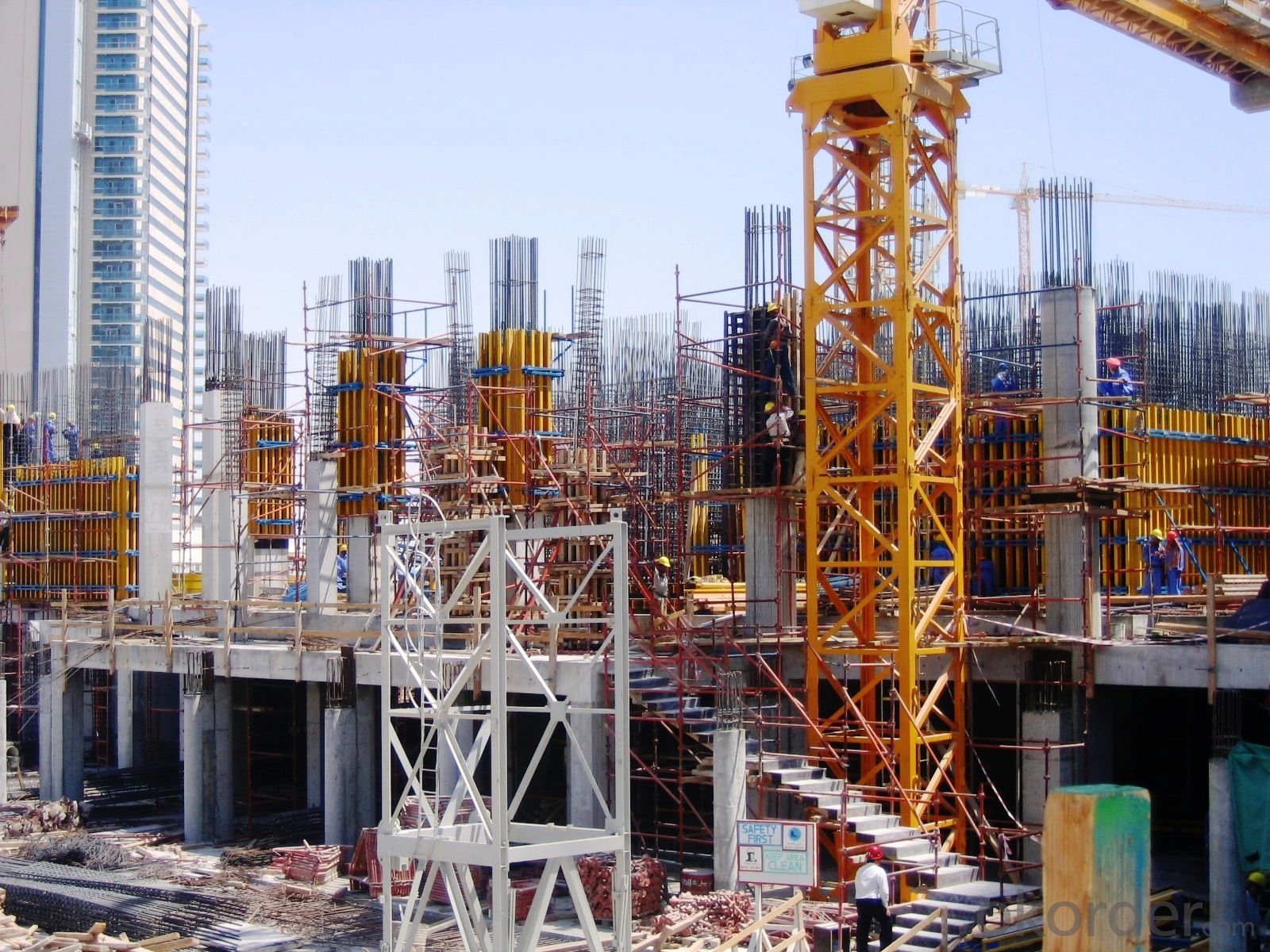

- Q:What are the different types of formwork connections used with steel frame formwork?
- Steel frame formwork can be used with several different types of connections to securely join the formwork panels together during the concrete pouring process. Some commonly used connections include the following: 1. Wedge connections: Steel wedges are inserted into pre-drilled holes in the formwork panels and tightened to hold the panels securely. 2. Bolted connections: Bolts, nuts, and washers are used to join the formwork panels. Holes are drilled in the panels and bolts are inserted through them, with nuts and washers tightened to secure the panels. 3. Pin and wedges connections: Steel pins are inserted into holes in the formwork panels, and wedges are driven into slots on the pins to hold the panels together. 4. Clamping connections: Clamps or clamping devices are used to join the formwork panels. These clamps are tightened around the panels, applying pressure for a secure connection. 5. Magnetic connections: Magnets embedded within the formwork panels create a strong bond between them, eliminating the need for additional connectors. 6. Hook and loop connections: Straps with hook and loop fasteners are used to join the formwork panels. These straps are wrapped around the panels, providing a secure connection. The choice of formwork connection depends on factors such as project requirements, the formwork system being used, and the desired level of ease and speed of assembly. Each type of connection has its own advantages and disadvantages.
- Q:Can steel frame formwork be used in projects with limited budget constraints?
- Indeed, steel frame formwork is suitable for projects with restricted budget limitations. Although the initial cost of steel frame formwork may be higher compared to other formwork types, it offers numerous advantages that can compensate for this expense. To begin with, steel frame formwork is extremely durable and can be utilized multiple times, making it cost-effective in the long term. Unlike traditional timber formwork, steel frame formwork does not warp, shrink, or absorb moisture, ensuring consistent and precise concrete shapes and dimensions. This durability also eliminates the need for frequent repairs or replacements, reducing maintenance expenses. Moreover, steel frame formwork enables faster construction due to its simple assembly and disassembly process. This not only saves time but also decreases labor costs. Additionally, the precise and rigid nature of steel frame formwork guarantees high-quality finishes, minimizing the necessity for additional surface treatments or corrections. Additionally, steel frame formwork offers design versatility, allowing for the achievement of a wide range of shapes and sizes. This flexibility eliminates the requirement for custom-made formwork, which can be expensive, and results in cost savings in terms of material usage. Lastly, steel frame formwork can be rented or leased, providing a more budget-friendly alternative for projects with limited financial resources. Renting formwork enables cost-sharing among multiple projects and eliminates the need for upfront capital investment. In conclusion, despite the higher initial cost, steel frame formwork's durability, construction speed, design versatility, and rental options make it a viable choice for projects with limited budget constraints.
- Q:How does steel frame formwork handle concrete pouring in earthquake-prone areas?
- Steel frame formwork is a highly effective method for handling concrete pouring in earthquake-prone areas due to its inherent strength and flexibility. The steel frame provides a robust structure that can withstand the forces exerted during an earthquake, ensuring the safety of the concrete pour and the overall stability of the structure. One of the key advantages of steel frame formwork is its ability to absorb and dissipate the energy generated by seismic activity. The steel frame acts as a strong and rigid support system, distributing the seismic forces evenly throughout the structure. This helps to reduce the impact on the concrete pour itself and minimizes the risk of any significant damage. Additionally, steel frame formwork is designed to be easily adjustable and adaptable, allowing for quick modifications to the formwork system as needed. This flexibility is essential in earthquake-prone areas, where the ground conditions and the magnitude of seismic activity can vary. It ensures that the formwork can be modified to accommodate any changes or adjustments required during and after an earthquake, without compromising the integrity of the concrete pour. Moreover, steel frame formwork is highly durable and long-lasting, making it ideal for use in seismic zones. The strength and resilience of steel allow it to withstand the repetitive loading and shaking caused by earthquakes over an extended period. This durability ensures that the steel formwork can withstand multiple seismic events, providing a reliable and safe solution for concrete pouring in earthquake-prone areas. In conclusion, steel frame formwork offers a robust and flexible solution for handling concrete pouring in earthquake-prone areas. Its strength, adaptability, and durability make it an ideal choice to handle the seismic forces generated during earthquakes, ensuring the safety and stability of the concrete pour and the overall structure.
- Q:How does steel frame formwork handle the placement of façade elements and architectural features within the concrete structure?
- Steel frame formwork provides a versatile and flexible solution for handling the placement of façade elements and architectural features within the concrete structure. The steel frames can be adjusted and customized according to the specific requirements of the design, allowing for precise positioning of elements such as windows, doors, and decorative façade panels. Additionally, the steel frame formwork provides strong support and stability during the pouring and setting of the concrete, ensuring that the architectural features are seamlessly integrated into the structure.
- Q:How does steel frame formwork handle the placement of reinforcement bars within the concrete structure?
- Steel frame formwork handles the placement of reinforcement bars within the concrete structure by providing a rigid framework that holds the bars in place during the pouring and curing process. The steel frame formwork ensures that the reinforcement bars are positioned correctly and securely, preventing any movement or displacement that could compromise the strength and structural integrity of the concrete.
- Q:Can steel frame formwork be used in curved or irregular shapes?
- Yes, steel frame formwork can be used in curved or irregular shapes. Its flexibility and adaptability make it suitable for creating customized formwork designs to accommodate various shapes and sizes.
- Q:What are the different types of concrete vibrators used with steel frame formwork?
- There are various types of concrete vibrators that can be used with steel frame formwork, including internal vibrators, external vibrators, and surface vibrators. Internal vibrators, also known as immersion or poker vibrators, are inserted directly into the concrete during the pouring process to consolidate the mixture and eliminate air pockets. External vibrators, on the other hand, are placed on the surface of the formwork to vibrate and compact the concrete from the outside. Surface vibrators are used to level and smooth the concrete surface after it has been poured and consolidated.
- Q:Does steel frame formwork require any specific foundation or support system?
- Yes, steel frame formwork does require a specific foundation or support system. The foundation or support system is necessary to provide stability and ensure the formwork can withstand the weight and pressure of the concrete being poured. The foundation or support system typically consists of steel or concrete beams, columns, or walls that are designed to distribute the load evenly and prevent any deformation or collapse of the formwork. Additionally, the foundation or support system may also include adjustable props, braces, or tie rods to further reinforce and stabilize the formwork during the concrete pouring and curing process. It is important to carefully plan and construct the foundation or support system to ensure the safety and durability of the steel frame formwork structure.
- Q:Can steel frame formwork be used for healthcare and medical facilities construction?
- Yes, steel frame formwork can be used for healthcare and medical facilities construction. Steel frame formwork is known for its strength, durability, and versatility, making it suitable for various construction projects including healthcare and medical facilities. It provides a stable and secure framework that can support the weight of heavy concrete structures, ensuring the safety and stability of the building. Additionally, steel frame formwork can be easily assembled, disassembled, and adjusted, allowing for flexibility in design and efficient construction processes. Moreover, steel is a non-combustible material, which is important for healthcare and medical facilities that require high fire safety standards. Overall, steel frame formwork is a reliable and efficient choice for constructing healthcare and medical facilities.
- Q:What are the key considerations for selecting the appropriate steel frame formwork contractor?
- When selecting the appropriate steel frame formwork contractor, there are several key considerations that should be taken into account. These considerations include the contractor's experience and expertise, their track record and reputation, their safety record, their pricing and value for money, and their ability to meet project deadlines. Firstly, it is important to assess the contractor's experience and expertise in steel frame formwork. This can be done by reviewing their portfolio of past projects, as well as their qualifications and certifications. A contractor with extensive experience in steel frame formwork will have the necessary skills and knowledge to handle the complexities of the job efficiently and effectively. Secondly, the contractor's track record and reputation should be carefully evaluated. This can be done by checking references and reading reviews or testimonials from previous clients. A contractor with a solid track record and positive reputation is more likely to deliver high-quality work and provide excellent customer service. Safety is another crucial consideration when selecting a steel frame formwork contractor. It is important to ensure that the contractor has a strong safety record and follows all necessary safety protocols. This can be determined by reviewing their safety certifications and asking about their safety procedures and training programs. Pricing and value for money are also important considerations. While it is natural to want to find the most cost-effective option, it is equally important to consider the quality of work and materials provided by the contractor. It is recommended to obtain multiple quotes and compare them, taking into account the contractor's experience, reputation, and the scope of the project. Finally, the contractor's ability to meet project deadlines should be considered. It is important to ensure that the contractor has the capacity and resources to complete the project within the specified timeframe. This can be determined by discussing project timelines and deadlines with the contractor and assessing their project management capabilities. In conclusion, selecting the appropriate steel frame formwork contractor requires careful consideration of their experience, track record, safety record, pricing, and ability to meet project deadlines. By evaluating these key factors, you can make an informed decision and choose a contractor that will deliver high-quality work and meet your project requirements.
1. Manufacturer Overview |
|
|---|---|
| Location | |
| Year Established | |
| Annual Output Value | |
| Main Markets | |
| Company Certifications | |
2. Manufacturer Certificates |
|
|---|---|
| a) Certification Name | |
| Range | |
| Reference | |
| Validity Period | |
3. Manufacturer Capability |
|
|---|---|
| a)Trade Capacity | |
| Nearest Port | |
| Export Percentage | |
| No.of Employees in Trade Department | |
| Language Spoken: | |
| b)Factory Information | |
| Factory Size: | |
| No. of Production Lines | |
| Contract Manufacturing | |
| Product Price Range | |
Send your message to us
Adjustable H20 Timber Beam Formwork
- Loading Port:
- China Main Port
- Payment Terms:
- TT OR LC
- Min Order Qty:
- -
- Supply Capability:
- -
OKorder Service Pledge
OKorder Financial Service
Similar products
New products
Hot products
Hot Searches
Related keywords







